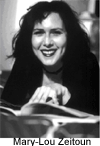 Sooner or later someone will look into why so many contemporary Canadian women are writing novels about neglectful mothers. To varying degrees, books by Kelli Deeth, Sue Goyette, Priscila Uppal and Kristen den Hartog feature young female characters staggering into womanhood minus strong maternal role models.
Sooner or later someone will look into why so many contemporary Canadian women are writing novels about neglectful mothers. To varying degrees, books by Kelli Deeth, Sue Goyette, Priscila Uppal and Kristen den Hartog feature young female characters staggering into womanhood minus strong maternal role models.
Now Marnie Harmon, the sassy heroine of Mary-Lou Zeitoun's novel, 13, joins the ranks of the unguided. Most of the story unfolds in 1980, the year Marnie enters her teens. Like many girls her age, she despises everything about her life: She hates her parents, who appear to have tuned her out; she hates her co-ed Catholic school and Green Vista, her suburban Ottawa neighbourhood. Most of all, she hates men, young and old, for their insistent lewdness and prejudice against women. That goes double for Mr. Carter, her perverted media-arts teacher.
Marnie does love reading, her girlfriends, a good laugh and at least one individual of the male persuasion: John Lennon. Marnie regards Lennon as a musical genius and is planning to meet him. The singer's idealistic anthem, Imagine, runs counterpoint to the novel's theme of sexual aggression.
To combat her burgeoning sense of vulnerability, the belief that her parents have emotionally abandoned her, Marnie deploys a barbed, cynical humour. She describes her parents as a couple pathologically consumed with appearances: "You could be dying in my house but if it would be embarrassing to save you they wouldn't save you."
She finds her mother's incessant perkiness, forced and dangerously false: "'Marnie don't be so Negative,' my mother always said. Mom would get mad at Anne Frank for being scared of the Nazis. Mom would think Anne Frank was being Negative."
It is Mrs. Harmon's perverse positivity that blinds her to the menace Mr. Carter presents.
Marnie and her best friends, Caroline and Edna, are a giddy trio, dissolving into laughter at the slightest provocation. Their hysterical mirth binds them in tacit understanding of their unsettling shared experience. Marnie is actually touchingly hopeful and idealistic. An avid reader, she works part-time at the library. She wishes her home life resembled the images of domestic contentment found in the stories of Laura Ingalls Wilder.
A number of crushing incidents twist Marnie's youthful animus into troubled teendom. The gym teacher kicks Marnie off the track team after she complains about the revealing uniforms; her music teacher prevents her from learning to play the drums because he believes that drums are not for girls; and her friend Caroline is sexually assaulted.
Marnie's increasingly foul mouth reflects her new rock and roll circle of friends. But it is also her way of rebelling against the "nice" language, attached to the "nice" people that ignore evil acts against girls.
This is a first novel for Mary-Lou Zeitoun. Her seedy portrait of the lecherous teachers at Marnie's Catholic school seems timely¨an eerie echo of the current sexual scandal involving Catholic priests and children. The story is also timeless in its picture of ordinary, alienated adolescence. Zeitoun superbly creates a character every adult reader will in some way recognize as a younger self. Our familiarity allows us to set up surveillance inside Marnie's head. At the same time, we remain at a far enough remove to objectively consider her actions.
At 134 pages, 13 is a short book and yet, a fully developed novel, with a multi-dimensional plot. It has crisp, economical prose that whisks us along. In addition, the story is surprisingly suspenseful: one can never be certain what choices Marnie will make, what she will say, how far she will go or what repercussions she will face. The novel is 134 pages long because that is as long as it needs to be. Zeitoun's unwillingness to inflate plot or theme proves she is in possession of a rare literary confidence.
Early in the novel, Marnie contemplates her library's Dewey decimal system: "...I don't know why they didn't just put the literature books in the fiction section (filed alphabetically by author ) the literature books were just as good."
This statement is ironically-comically- true, for few thicker, loftier novels work as well as this slight one. Many "more serious" books are successful much of the time, or shine in places, but 13 does what it's supposed to do all the way through.
While not exactly mainstream¨it's too caustically relevant for that¨13 could still become a classic. It's the kind of book capable of turning resistant teenage readers into voracious inhalers of words. I plan to pass the novel down to my daughter when she hits her teens. In the war between the generations, 13 is a no-man's land where mothers and daughters can meet. ˛